Explore Aizuwakamatsu - Japan Travel, Asia
Aizuwakamatsu, located in the center of Fukushima Prefecture, is a city that perfectly combines samurai heritage, natural beauty, and rich culture. Aizuwakamatsu, also known as the "Samurai City," provides visitors with a deep dive into Japan's feudal past through well-preserved castles, historical landmarks, and museums that recount the tale of the Aizu Clan and its significant role in Japanese history.
Seeking a tailored Japan adventure? Explore our premium Japan tour offerings here.
Population: Approximately 120,000 in 2020.
Economy: Aizuwakamatsu’s economy is driven by tourism, traditional crafts like lacquerware, sake production, and agriculture, particularly rice farming. The city also supports small local businesses and artisans.
Landmarks: Famous for the Tsuruga Castle (or Aizu-Wakamatsu Castle), Iimoriyama Hill & Byakkotai Memorial, and the Ouchi-juku Post Town.
Japan
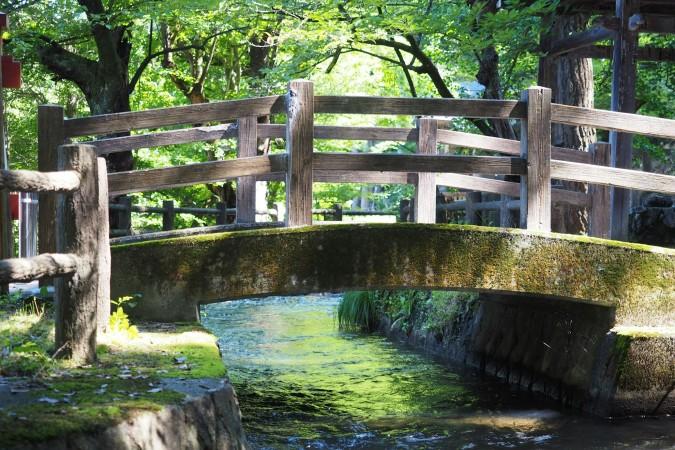
Overview of Aizuwakamatsu
Historical & Cultural Influence
Aizuwakamatsu is rich in historical significance, especially linked to samurai culture. Its most iconic landmark is Tsuruga Castle, a grand structure that played a pivotal role during the Boshin War of 1868, a civil war that shaped modern Japan. Today, Tsuruga Castle stands as a symbol of the city’s resilience and rich history. In addition to taking in sweeping views of the city from the top of the castle, visitors can peruse the museum and learn about the Aizu Samurai who formerly protected the area. Walking through this city feels like stepping into a different era, making it a popular destination for history enthusiasts.
Interaction with the Locals
Aizuwakamatsu's citizens are known for their strong sense of pride in their samurai heritage and deep-rooted cultural traditions. The people of Aizuwakamatsu are friendly and welcoming, often eager to share their local customs with visitors. Despite its historical significance, the city maintains a peaceful, small-town atmosphere, where locals are closely connected to the area's history, from traditional crafts like Aizu lacquerware to its famous sake brewing.
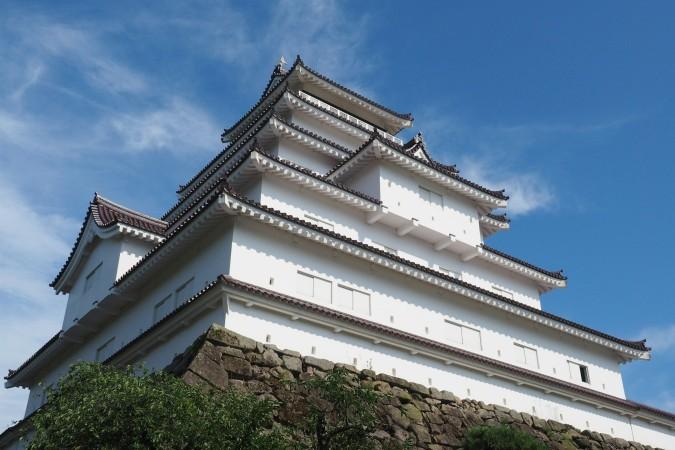
Tsuruga Castle (Aizu-Wakamatsu Castle) - © Shino Nakamura
Top Attractions in Aizuwakamatsu
Aizuwakamatsu offers a wealth of attractions that allow travelers to immerse themselves in Japan’s history, culture, and natural beauty. Whether you're exploring grand castles, historical villages, or scenic landscapes, the city has something for everyone.
Tsuruga Castle (Aizu-Wakamatsu Castle)
Tsuruga Castle, also known as Aizu-Wakamatsu Castle, is the crown jewel of the city. Originally built in the late 14th century, this iconic structure played a pivotal role in the Boshin War, a civil war that marked the end of the samurai era. Today, Tsuruga Castle serves as a museum that showcases the history of the Aizu Clan and their contributions to Japan’s feudal period.
Iimoriyama Hill and Byakkotai Memorial
Iimoriyama Hill is both a scenic and somber site in Aizuwakamatsu. It’s famous for the Byakkotai (White Tiger Corps), a group of 20 teenage samurai who tragically took their own lives during the Boshin War, believing their beloved Aizu had fallen. A visit to the Byakkotai Memorial allows travelers to reflect on the loyalty and bravery of these young warriors, who are remembered as heroes in Japanese history.
Ouchi-juku Post Town
A short drive from Aizuwakamatsu city center, Ouchi-juku is a beautifully preserved post town that dates back to the Edo period. Walking through its main street lined with traditional thatched-roof houses, you'll feel as if you've stepped back in time to the 17th century. The town is known for its unique culinary offerings, especially negi soba, where soba noodles are served with a long green onion used in place of chopsticks.
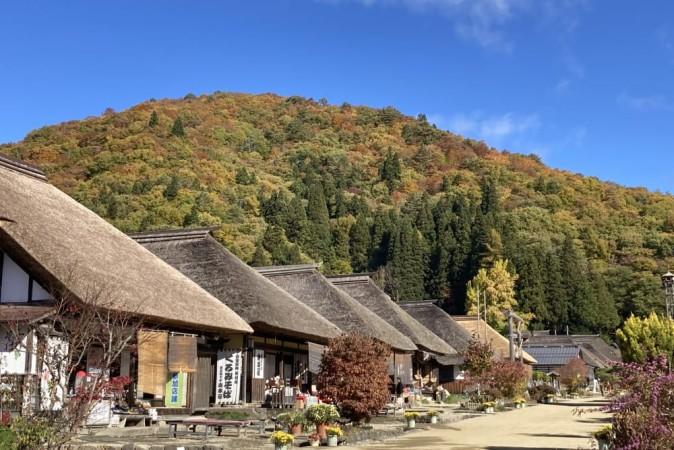
Ouchi-juku Post Town - © Japan National Tourism Organization
Must-Try Dishes in Aizuwakamatsu
Aizuwakamatsu is a hidden gem for food lovers, offering a variety of dishes that highlight the region’s culinary traditions, the use of local ingredients and the unique flavors you’ll only find in the Fukushima region.
- Kozuyu: Kozuyu is a clear soup that holds a special place in Aizu’s culinary culture that is served at celebrations and during the New Year. Kozuyu is made from a broth of dried scallops, shiitake mushrooms, carrots, taro, and other vegetables yet its umami-rich flavor is a symbol of Aizu's simplicity.
- Wappa Meshi: Wappa Meshi is a traditional Aizu cuisine of steamed rice topped with seasonal vegetables, mushrooms, and fish, served in a round wooden container known as a "wappa." The cedar container gives the food a lovely scent, which enhances the flavors.
- Aizu Sake: The area’s clean mountain water and cold winters provide the perfect conditions for brewing high-quality sake. Many local breweries offer tours and tastings, allowing visitors to sample a wide variety of flavors, from dry and crisp to sweet and fragrant.
- Nishin Soba: Nishin Soba, a soba noodle dish prepared with dried herring rehydrated and simmered in a sweet soy sauce broth, is another local favorite. The herring's deep taste complements the soba noodles, resulting in a dish that is both robust and delicate.
- Aizu Sweets: Aizu has its own unique array of traditional sweets, Awa Manju and Aizu Miso Manju. Awa Manju is a steamed bun filled with red bean paste and covered with millet, which has a somewhat chewy feel while Aizu Miso Manju is another sweet treat, made from a soft bun filled with sweetened miso paste, combining savory and sweet flavors for a distinct dessert experience.
Explore the unique charm of Wajima, another must-visit place in Japan, in our article here.
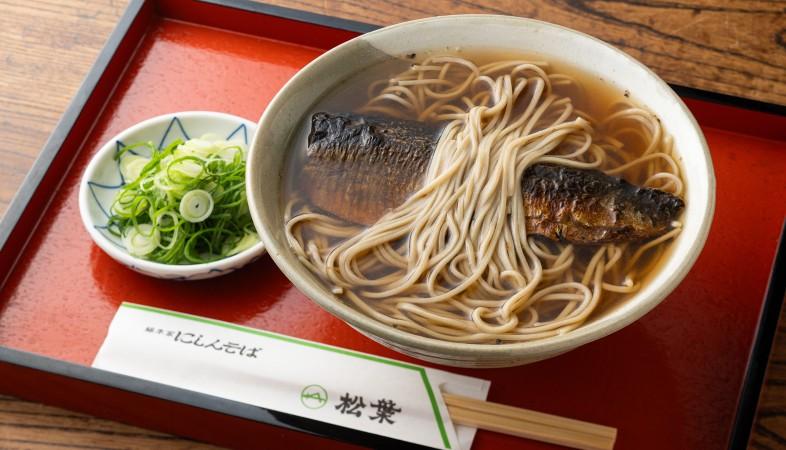
Nishin Soba - © 京都市中央市場仲卸業者オススメ
Festivals & Local Celebrations
Aizuwakamatsu is a city that loves to celebrate its history and culture, with numerous festivals held throughout the year. These events offer a fantastic opportunity for visitors to experience the city’s vibrant traditions and local customs, from historical reenactments to festive celebrations of the seasons.
Aizu Autumn Festival
The Aizu Autumn Festival is a big event conducted in September to highlight the city's samurai past. The highlight of the festival is the Samurai Parade, where hundreds of participants dressed in traditional armor march through the streets, reenacting famous battles and moments from Aizu’s history. The festival also includes food stalls, traditional dance performances, and a spectacular fireworks display.
Ouchi-juku Snow Festival
Taking place in February, the Ouchi-juku Snow Festival transforms the old post town into a winter wonderland as the thatched-roof houses of Ouchi-juku are covered in snow, illuminated by lanterns, creating a magical atmosphere. The festival features traditional performances, fireworks, and local food stalls offering hot, comforting dishes like negisoba.
Tsuruga Castle Cherry Blossom Festival
Spring in Aizuwakamatsu is marked by the Tsuruga Castle Cherry Blossom Festival, where the castle grounds come alive with the beauty of sakura (cherry blossoms). Visitors gather to enjoy hanami (flower viewing), with picnics under the blooming trees. The festival also features traditional music and performances, as well as night-time illuminations of the cherry blossoms, creating a romantic and serene ambiance.
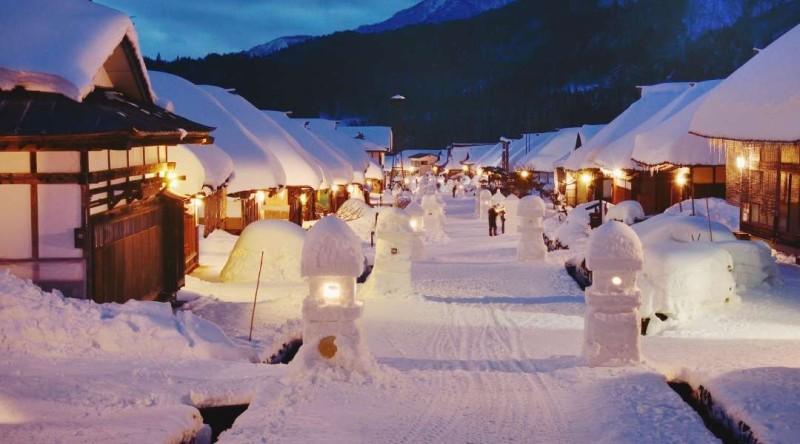
Ouchi-juku Snow Festival - © Japan National Tourism Organization
What to Do in Aizuwakamatsu
- Onsen Retreat at Higashiyama Onsen: Nestled in a scenic valley, Higashiyama Onsen has been a popular onsen destination for centuries. Many traditional Japanese inns feature outdoor baths with views of the surrounding mountains and rivers. The mineral-rich waters are perfect for soothing tired muscles after a day of sightseeing.
- Outdoor Adventures: Aizuwakamatsu is surrounded by beautiful natural landscapes that offer plenty of outdoor activities. In the warmer months, visitors can enjoy hiking in the nearby mountains or taking sightseeing boat rides on Lake Inawashiro, one of Japan’s largest lakes. In winter, the region offers skiing opportunities at resorts near Aizu, making it a great destination for both summer and winter activities.
- Cultural Tours: For a deeper understanding of Aizuwakamatsu’s rich history, consider joining a guided cultural tour. These tours take you through the city’s most important historical sites, such as Tsuruga Castle, Aizu Bukeyashiki, and Iimoriyama Hill, with knowledgeable guides sharing insights into the city’s samurai past.
Shopping in Aizuwakamatsu
- Aizu Lacquerware Stores: One of Aizuwakamatsu’s most famous crafts is Aizu lacquerware, known for its durability and intricate designs. The lacquerware is often decorated with gold leaf and features motifs inspired by nature and samurai symbols. Many local shops and workshops in the city offer a range of lacquerware products, including dishes, trays, and tea sets. Some workshops even offer hands-on experiences, where visitors can try their hand at painting their own lacquerware pieces.
- Nanokamachi-dori Street: For a traditional shopping experience, head to Nanokamachi-dori, a charming street lined with historical buildings and artisan shops. Here, you’ll find a wide variety of goods, from pottery and woodwork to traditional textiles. The street’s nostalgic atmosphere makes it a pleasant place to stroll, and shopkeepers are often happy to share the stories behind their products.
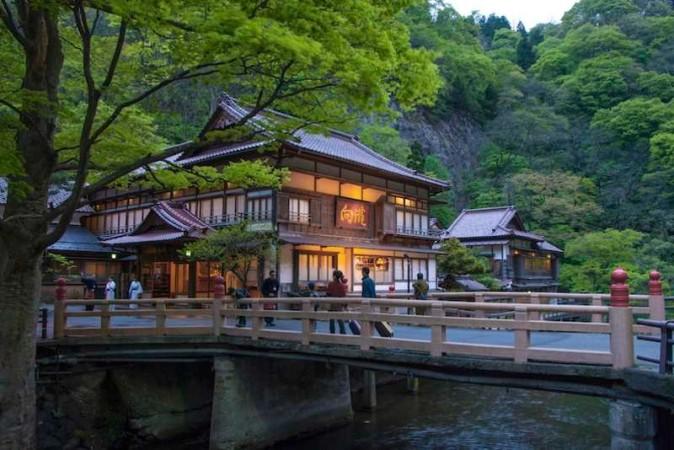
Onsen Retreat at Higashiyama Onsen - © Japan National Tourism Organization
Weather in Aizuwakamatsu: Best Time to Visit
Spring in Aizuwakamatsu
Spring in Aizuwakamatsu is a delightful time to visit, with mild temperatures and vibrant cherry blossoms. March can still be a bit chilly, but by April, the city is in full bloom, especially around Tsuruga Castle, where the Cherry Blossom Festival takes place. Daytime temperatures range between 10°C and 20°C (50°F to 68°F), making it ideal for outdoor activities such as tourism and hanami (flower watching).
Summer in Aizuwakamatsu
Summer brings warm weather and lush greenery to Aizuwakamatsu. With temperatures ranging from 20°C to 30°C (68°F to 86°F), this is the ideal time for hiking, exploring Lake Inawashiro, or enjoying a boat tour. Though summer is generally pleasant, July and August may see some rainy days, so it’s wise to pack an umbrella if you visit during this period.
Autumn in Aizuwakamatsu
Autumn is arguably one of the most beautiful times to visit Aizuwakamatsu as the city’s parks, temples, and mountains come alive with stunning autumn foliage. The crisp, cool air (ranging from 10°C to 20°C or 50°F to 68°F) makes it comfortable to explore attractions like Iimoriyama Hill and Ouchi-juku. The Aizu Autumn Festival, held in September, also adds a festive atmosphere to the city.
Winter in Aizuwakamatsu
Winter in Aizuwakamatsu is cold and snowy, with temperatures often dropping below freezing. The city’s surrounding mountains are ideal for skiing and snowboarding, while Ouchi-juku becomes a snow-covered fairytale during the Ouchi-juku Snow Festival. This is also the perfect time to soak in a warm onsen at Higashiyama Onsen. If you enjoy winter sports or scenic snowy landscapes, this is a magical time to visit.
Explore the unique charm of Osaka, another must-visit place in Japan, in our article here.

Witness Aizuwakamatsu's natural beauty - © Chuck Eugene
Essential Travel Information
Getting Around Aizuwakamatsu
- Local Buses: Aizuwakamatsu operates a reliable local bus network that connects the city’s major attractions. These buses typically run at regular intervals throughout the day, making it easy to hop on and off as you explore. Many routes are designed with tourists in mind, stopping at key historical and cultural sites, making them a convenient option for sightseeing.
- Taxis: Taxis are widely available in Aizuwakamatsu, especially near transportation hubs, hotels, and major attractions. Taxis are a convenient choice for those looking for a quicker or more private mode of transport. While taxis can be more expensive than other options, drivers are generally familiar with the city’s landmarks, making it easy to reach your destination.
- Bicycle Rentals: Biking is a great way to enjoy the scenic beauty of the city, with several bike-friendly routes that lead through historical sites and natural landscapes. It’s a sustainable and fun way to navigate the city, allowing you to stop and explore at your own pace.
- Walking: Aizuwakamatsu is a walkable city, especially within the downtown area and around Tsuruga Castle. Walking between attractions is not only convenient but also gives you the opportunity to explore local shops, cafes, and hidden gems along the way.
ATM & Banking Services
In Aizuwakamatsu, ATMs that accept international cards are readily available at convenience stores and post offices, making it easy for visitors to access cash. While some local businesses accept credit cards, it’s a good idea to carry cash, especially when visiting smaller shops or rural areas. Currency exchange services are limited, so exchanging money before arriving or at major transport hubs is recommended.
Where to Stay in Aizuwakamatsu
- Ryokan: For an authentic Japanese experience, staying in a ryokan is a must. These traditional Japanese inns feature tatami mat rooms, futons, and onsen baths, offering a glimpse into Japanese hospitality and culture. Many ryokan in Aizuwakamatsu serve multi-course kaiseki meals that highlight local ingredients and flavors.
- Western-Style Hotels: These accommodations offer amenities like Wi-Fi, comfortable beds, and on-site restaurants serving both Japanese and Western cuisine. Western-style hotels are often conveniently located near transportation hubs, making them ideal for travelers who want easy access to the city's main attractions and public transport.
- Budget Lodgings: If you’re traveling on a budget, guesthouses and hostels provide affordable accommodation options without sacrificing comfort. Guests can often stay in traditional tatami mat rooms, and communal dining areas provide opportunities to interact with other travelers. These budget-friendly options are ideal for those looking to immerse themselves in the local culture while saving on accommodation costs.
Articles for you

Explore Yala National Park - Sri Lanka Travel, Asia
Tucked away in Sri Lanka’s southeastern corner, Yala National Park is where wild nature meets deep tradition. Known worldwide for its leopard population, the park is also home to elephants, sloth bears, crocodiles, and hundreds of bird species. Beyond wildlife, Yala opens doors to a cultural landscape dotted with ancient temples, Buddhist ruins, and coastal villages. For travelers seeking more than just a safari, Yala offers a chance to explore eco-tourism, local communities, and sacred heritage sites.
Population: The Yala National Park area doesn’t have a human population.
Economy: The economy around Yala National Park thrives on a blend of eco-tourism, agriculture, and local services. Safari tours, eco-lodges, and cultural experiences drive steady income for nearby towns like Tissamaharama and Kataragama, supporting thousands of families.
Landmarks: Famous for Block I of Yala and wildlife encounters, including elephants, sloth bears, crocodiles, and exotic bird species.

Explore Galle - Sri Lanka Travel, Asia
Nestled on Sri Lanka’s southern coastline, Galle is a vibrant city where history meets the sea. Its cobbled streets, colonial architecture, and serene beaches make it a must-visit destination for travelers seeking a blend of culture, adventure, and relaxation. A UNESCO World Heritage site, Galle captivates visitors with its Dutch Fort, bustling markets, and friendly locals. Whether you’re exploring the ramparts at sunset or savoring fresh seafood by the shore, Galle promises an unforgettable journey into Sri Lanka’s heritage.
Population: Approximately 113,000 in 2023.
Economy: Galle’s economy thrives on tourism, trade, and fisheries. The city’s historic fort, colonial architecture, and coastal charm draw thousands of international visitors each year, making tourism its main economic driver. Fishing remains vital for local livelihoods, supplying fresh seafood across the region.
Landmarks: Famous for the Galle Fort, Dutch Reformed Church & Maritime Museum, and Unawatuna Beach.

Explore Bentota - Sri Lanka Travel, Asia
Nestled along Sri Lanka’s southwestern coast, Bentota is a tropical paradise that blends golden beaches, vibrant culture, and thrilling adventures. Famous for its calm waters, luxury resorts, and scenic river estuary, Bentota has become a top destination for travelers seeking both relaxation and authentic experiences. From serene beach walks at sunrise to adrenaline-pumping water sports, this coastal town offers a perfect balance of leisure and exploration. With its proximity to Colombo and Galle, Bentota is easy to reach, making it an ideal stop for both short escapes and extended holidays.
Population: Approximately 37,000 in 2023.
Economy: Bentota’s economy thrives mainly on tourism, which drives local businesses such as hotels, restaurants, and wellness retreats. The town also benefits from fishing, coconut cultivation, and handicrafts like wood carving and batik textiles. Many residents rely on the growing demand for water sports and Ayurvedic treatments, making tourism the backbone of both income and employment in the area.
Landmarks: Famous for Bentota Beach, Bentota River Safari, and Kande Vihara Temple.

Explore Mirissa - Sri Lanka Travel, Asia
Mirissa is a charming coastal town on Sri Lanka’s southern shoreline. Known for its golden beaches, turquoise waters, and vibrant marine life, it has become a must-visit stop for travelers exploring the island. Many come for whale watching, surfing, and sunset views at Coconut Tree Hill, but Mirissa offers much more than postcard beauty. The fishing boats you see anchored by the bay carry generations of stories. Local traditions, delicious cuisine, and a laid-back rhythm of life shape every visitor’s experience.
Population: Approximately 4,700 in 2023.
Economy: Mirissa’s economy is largely shaped by its coastal location. Fishing has long been the backbone of local livelihoods, with generations relying on the Indian Ocean for income. In recent decades, tourism has become the main driver of growth, thanks to whale watching, surfing, and beachside hospitality.
Landmarks: Famous for Mirissa Beach, Coconut Tree Hill, and Parrot Rock Bridge.

Explore Nuwara Eliya - Sri Lanka Travel, Asia
Tucked away in the Central Highlands of Sri Lanka, Nuwara Eliya is often called “Little England”. With its rolling tea plantations, cool misty mornings, and colonial charm, this mountain town feels like a step into another world. Travelers come here to breathe fresh air, walk through flower gardens, sip the finest Ceylon Tea, and enjoy a pace of life far from the island’s busy cities. Whether you’re drawn by scenic landscapes, heritage architecture, or the warmth of its people, Nuwara Eliya is a destination that blends nature, culture, and history in perfect harmony.
Population: Approximately 781,000 in 2023.
Economy: Nuwara Eliya’s economy thrives mainly on tea production, as it sits in the heart of Sri Lanka’s central highlands, famous worldwide for Ceylon Tea. The city also benefits from a growing tourism industry, attracting visitors with its colonial charm, cool climate, and scenic landscapes.
Landmarks: Famous for Gregory Lake, Hakgala Botanical Garden, and Victoria Park.

Explore Sukau - Malaysia Travel, Asia
Nestled on the banks of the Kinabatangan River in Sabah, Malaysian Borneo, Sukau is a destination where wildlife, culture, and conservation come together. Known as one of Asia’s top spots for river safaris and eco-tourism, this quiet village offers a front-row seat to encounters with Bornean orangutans, pygmy elephants, proboscis monkeys, and exotic birdlife.
Population: Approximately 1,400 in 2019.
Economy: Sukau’s economy is shaped by its riverine location and natural resources. Traditionally, the Orang Sungai community relied on fishing, small-scale farming, and forest gathering for their livelihood. Today, the village has shifted toward eco-tourism, with river cruises, jungle trekking, and homestays providing income.
Landmarks: Famous for the Kinabatangan River cruises, Gomantong Caves, and Ox-bow lakes and wetlands.
